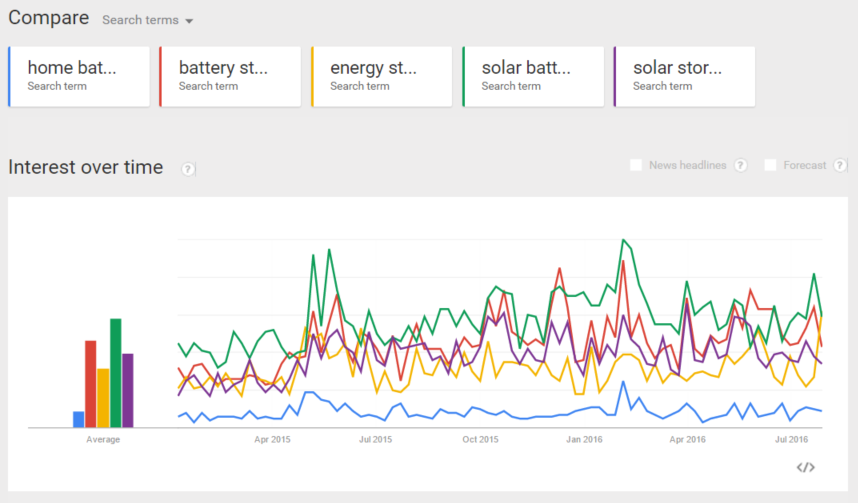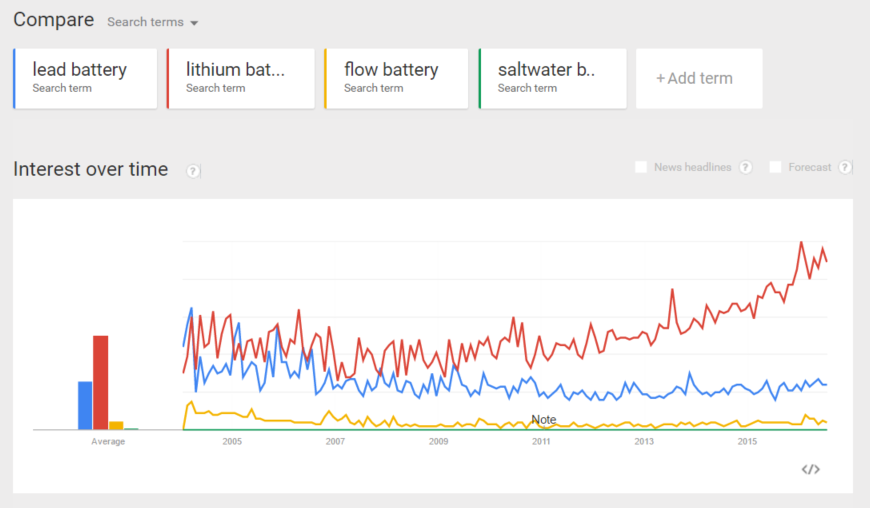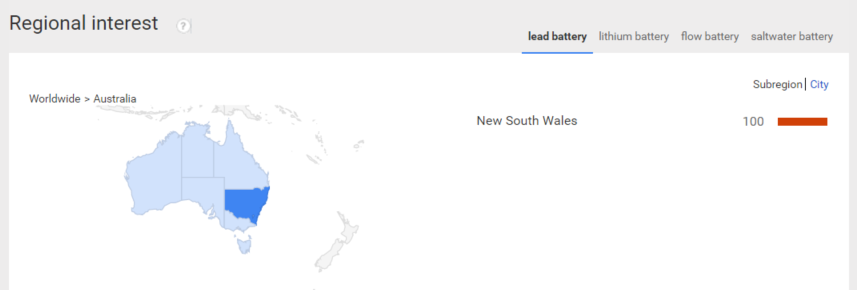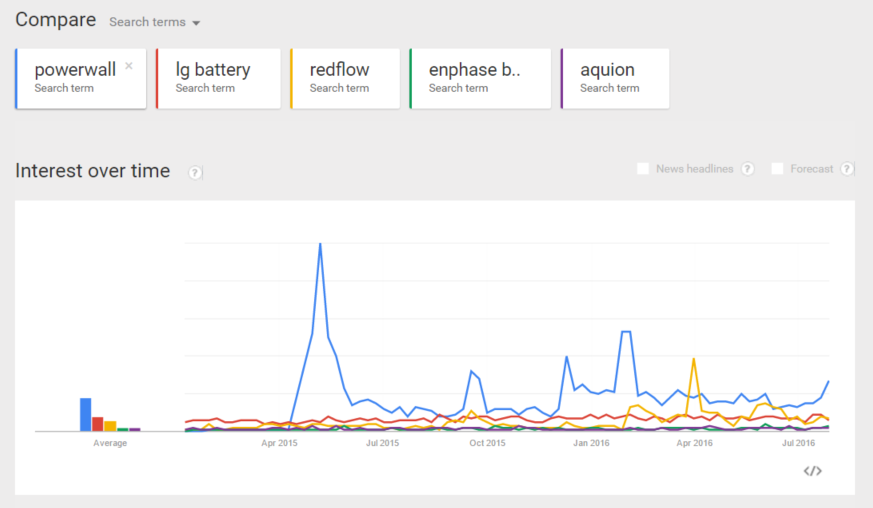There are only so many ways to start writing an article with some variation of ‘interest in battery storage in Australia is growing rapidly’ without repeating yourself, but that’s exactly what I have valiantly attempted to do over the past 1.5 years. Here, I’ve put together some charts that attempt to explain why I’ve felt compelled to reiterate this phrase so many times.
Is it ‘energy storage’? ‘Solar batteries’? Finding the common language.
I wanted data to back up my frequent statements about how battery-happy Australian have become, so I had a look at data from the Google Trends explorer, a useful (and free) tool that shows how often people use certain terms in Google Search over time by geographical area. Because ‘battery’ is way too general, I picked out a handful of solar & battery-related terms to see what people have been looking for.
As you can see in the chart below, it varies. Generally speaking, ‘solar batteries’ seems to be the word combination of choice, but ‘battery storage’ appears to have gained the most traction in Australia in the last 18 months. The overall trend is definitely upwards, although the actual number of searches in a month is influenced a lot by what’s in the news. For example, the spikes around May of 2015 are almost undoubtedly associated with the announcement of Tesla’s Powerwall, while the one in February of this year happened mainly thanks to the Catalyst episode about home battery storage.
A handful of energy storage-related search terms and how often they’ve been used in Australia over the past 18 months. (Full report on Google Trends.)
Interestingly, different states seem to prefer using different terms – but this could change over time as common language develops around the topic.
‘Solar storage’ used a lot in NSW and VIC?
‘Solar batteries’ appears to be the term of choice in QLD.
While ‘battery storage’ is used a lot on both coasts, WA seems to like it a bit more.
Battery chemistry types
For decades, lead batteries were the batteries for solar energy storage, but in recent years other battery chemistries have started to become popular as well. Lithium batteries are the ones that have gained the most traction, however, and the chart below illustrates this pretty clearly. (Keeping in mind that both lead batteries and lithium batteries have uses outside of home energy storage – most notably the use of lithium batteries in a huge range of small electronic devices.)
The other two battery types listed here are both very promising for the stationary energy storage market, but not so much for small-scale applications; this fact goes a long way towards explaining why their search volumes are so much lower than those for lead and lithium batteries.
Flow batteries are actually more of a category of battery than a chemistry type (you can read about them here), but for now we’ll leave them in the same bucket. Only a couple of companies make batteries that are commercially available here (namely: Imergy and RedFlow).
‘Saltwater batteries’ are only salty in the chemical sense, but the electrolyte does contain water. At present, Aquion is the only company that makes batteries of this composition.
Battery chemistry/type searches since 2004. Lithium has taken off like mad, while lead batteries have become relatively neglected in the public consciousness. (Check out the full report here on Google Trends.)
For some reason NSW seems to have a lot of interest in lead batteries (although I wouldn’t give this somewhat odd graph too much credence).
Interest in lithium batteries, on the other hand, seems to be a bit more spread out.
Home battery products
I’ve picked out five of the most buzz-wordy home battery storage products/manufacturers in Australia and plugged them into the explorer to see how much people have been looking for them over the past year and a half. The results are not completely surprising, but definitely enlightening. (You can explore the chart below in more detail yourself here.)
Searches for five specific battery storage products names since January 216. You can probably guess what the blue line is without reading the legend in the chart.
What Solar Choice has been seeing
Solar Choice hasn’t relied on paid advertising since 2011. Instead, all of our new customers find us through organic search engine queries. As such, the trends on our site are also something of a bellwether for broader interest in solar-related topics – when something about solar or batteries is on someone’s mind, they may look for further info online. In doing so, they’re likely to stumble across us (that’s our aim, anyhow!).
The two charts below track the steadily growing increase in battery storage-related traffic to our site since January 2015. The first shows that the monthly number of views of battery/storage-related pages has more than doubled over the last 18 months, while the second one shows how battery-related enquiries have jumped nearly 7-fold.
Pageviews of battery storage-related content on the Solar Choice website between Jan 2015 and July 2016.
Battery-related customer enquiries on the Solar Choice website since Jan 2016.
What does it all mean?
In short, I don’t think I’d be taking any risks in stating that the battery storage revolution is here. For those of you who, like me, want to point to something more than anecdotal when they talk about how home battery storage is quickly capturing the hearts and minds of many Australians, here is some pretty clear evidence.
© 2016 Solar Choice Pty Ltd
- Solar Power Wagga Wagga, NSW – Compare outputs, returns and installers - 13 March, 2025
- Monocrystalline vs Polycrystalline Solar Panels: Busting Myths - 11 November, 2024
- Solar Hot Water System: Everything You Need to Know - 27 February, 2024







